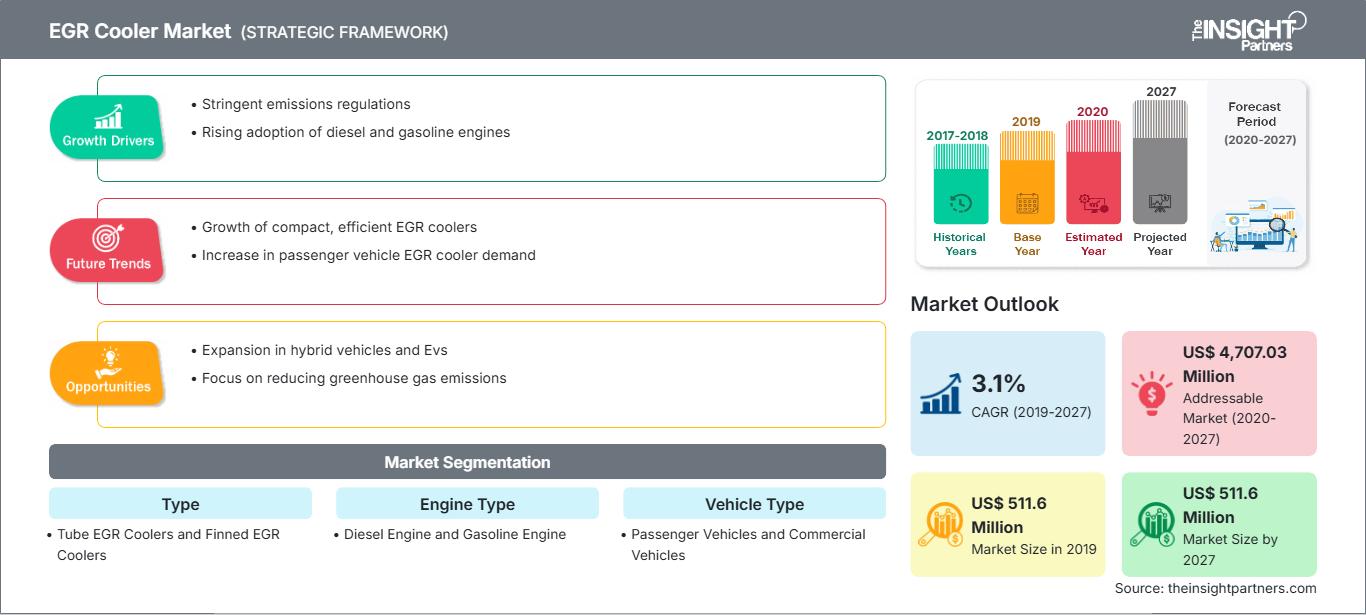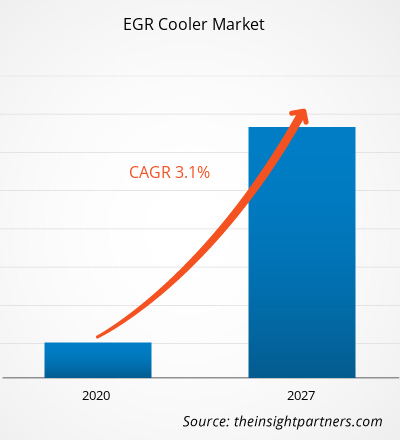[Informe de investigación] En términos de ingresos, el mercado global de enfriadores EGR se valoró en US$ 511,6 millones en 2019 y se proyecta que alcance los US$ 511,6 millones para 2027; se espera que crezca a una CAGR del 3,1% durante el período de pronóstico de 2020 a 2027.
El mercado de enfriadores EGR está segmentado en cinco regiones principales: Norteamérica, Europa, Asia-Pacífico, Oriente Medio y África (MEA) y Sudamérica. Norteamérica y la Unión Europea han implementado estrictas normas de emisiones para vehículos con motores diésel. Los programas regulatorios desarrollados en Norteamérica y Europa han servido históricamente como modelo para los programas adoptados en otras regiones. Países como Canadá, Corea del Sur y Japón se han mantenido al día con los avances en Estados Unidos y Europa. Para los países donde no se han promulgado normas, existe una gran oportunidad para mitigar las emisiones de contaminantes atmosféricos peligrosos de los vehículos. El sistema EGR ayuda a reducir la formación de gases NOX al disminuir la temperatura máxima de combustión y recircular los gases de escape no quemados. Por lo tanto, otros países en desarrollo se están enfocando en la adopción de sistemas avanzados de enfriadores EGR en sus vehículos. Además, se proyecta que otras regiones en desarrollo, como Oriente Medio y África (MEA) y Sudamérica, crecerán a un ritmo constante, gracias a las crecientes iniciativas gubernamentales para digitalizar la economía mediante la adopción de tecnologías avanzadas.
Obtendrá personalización en cualquier informe, sin cargo, incluidas partes de este informe o análisis a nivel de país, paquete de datos de Excel, así como también grandes ofertas y descuentos para empresas emergentes y universidades.
Mercado de enfriadores EGR: Perspectivas estratégicas

- Obtenga las principales tendencias clave del mercado de este informe.Esta muestra GRATUITA incluirá análisis de datos, desde tendencias del mercado hasta estimaciones y pronósticos.
Perspectivas del mercado: mercado de enfriadores EGR
Aumento de las normas de emisiones y estándares CAFÉ
La EGR ayuda a aumentar la eficiencia del combustible y reduce las emisiones junto con la potencia de salida del motor, generalmente haciendo circular gases tóxicos de regreso a la cámara de combustión para una mayor combustión.
Las múltiples normas de emisiones establecidas por gobiernos y diversas organizaciones, como la Agencia de Protección Ambiental (EPA) en Norteamérica, la EURO 6 en la Unión Europea y las Normas de Emisiones Bharat Stage en India, han propiciado la adhesión de los fabricantes de vehículos en sus respectivas regiones. Todas estas normas se centran en reducir las emisiones de monóxido de nitrógeno (NOx), dióxido de carbono (CO2), material particulado (PM) e hidrocarburos no metanólicos (NMHC), entre otros. Como se mencionó anteriormente, estas normas de emisiones han impulsado la invención de nuevas tecnologías destinadas a reducir la emisión de estos gases nocivos de los motores de combustión de los vehículos. La EGR es una de las técnicas que se utilizan para cumplir con estas normas de emisiones.
La EGR ayuda a circular los gases nocivos emitidos por un motor durante la combustión y distribuye una parte de ellos de vuelta al motor, que a su vez quema menos combustible y emite menos gases tóxicos.
Impacto de la COVID-19 en el mercado de enfriadores EGR
La aparición y rápida propagación del coronavirus (COVID-19) ha paralizado a numerosos países, tanto desarrollados como en desarrollo. El aumento continuo de pacientes infectados amenaza a diversas industrias a nivel mundial. En marzo de 2020, China, Italia, Estados Unidos, Irán, España, la República de Corea, Francia y Alemania se encontraban entre los países más afectados en cuanto a casos confirmados y fallecimientos. Según las últimas cifras de la OMS, el número de pacientes positivos confirmados por COVID-19 ascendía a 976.249 y el total de fallecimientos a 50.489 a nivel mundial. El brote de coronavirus ha afectado a las economías e industrias de varios países debido a confinamientos, prohibiciones de viaje y cierres de empresas.
Dado que la mayoría de los países están aplicando medidas de confinamiento, la demanda de enfriadores EGR está disminuyendo a un ritmo considerable. Esto se debe a que los principales países compradores de enfriadores EGR han restringido su inversión en estos componentes y están destinando un porcentaje considerable de su presupuesto a combatir la COVID-19. El cierre temporal de las plantas de fabricación también muestra una tendencia negativa en el mercado de enfriadores EGR. La continuidad de la propagación de la COVID-19 sería muy peligrosa para los actores del mercado de enfriadores EGR.
Información sobre segmentos de tipo
Según el tipo, el segmento de enfriadores EGR con aletas dominó el mercado global de enfriadores EGR en 2019. Los enfriadores EGR con aletas funcionan de acuerdo con los requisitos del cliente y son muy adecuados, especialmente para aplicaciones de motores de servicio liviano, además de brindar un rendimiento excepcional en condiciones de suciedad estabilizada.
Información sobre segmentos de tipos de motores
Según el tipo de motor, el segmento diésel dominó el mercado mundial de enfriadores EGR en 2019. Los motores diésel son un tipo de motor de combustión interna, cuyas temperaturas internas dentro de la cámara se estima que alcanzan hasta 2500 grados Fahrenheit en el momento de la operación de combustión.
Información sobre segmentos de tipos de vehículos
En cuanto al tipo de vehículo, los vehículos comerciales dominaron el mercado mundial de enfriadores EGR en 2019. Para cumplir con las normativas de emisiones actuales y futuras, los fabricantes de automóviles se están centrando en el desarrollo de enfriadores EGR para vehículos comerciales, junto con otras tecnologías como la reducción catalítica selectiva (SCR). Con altos requisitos de durabilidad y menores volúmenes de producción, la industria de vehículos comerciales exige una solución EGR que ofrezca un rendimiento excepcional y reduzca la complejidad.
Los actores del mercado se centran en innovaciones y desarrollos de nuevos productos integrando tecnologías y características avanzadas en sus productos para competir con la competencia.
- En 2020, BorgWarner Inc. exhibió sus productos de recirculación de gases de escape (EGR) en la feria de componentes Auto Expo 2020. Desde 2008, la empresa suministra sus enfriadores y tubos EGR para motores diésel de 1.3 litros a fabricantes indios de automóviles de pasajeros.
- En 2019, Hanon Systems expandió sus operaciones en el centro de México para impulsar su creciente negocio con fabricantes de automóviles de la región. La planta de fabricación opera bajo el nombre legal de Climate Systems Mexicana, SA de CV. La empresa traslada sus operaciones a un terreno de casi 15,000 metros cuadrados. Aumenta su capacidad para apoyar a los fabricantes de automóviles al incorporar productos de refrigeración del sistema de propulsión y transporte de fluidos a su producción.
- En 2019, BENTELER Automotive colaboró con fabricantes de automóviles en la implementación de su Sistema de Accionamiento Eléctrico BENTELER (BEDS), una solución para vehículos eléctricos. La compañía presentó su Sistema de Accionamiento Eléctrico 2.0 en Auto Shanghai. Este sistema es una plataforma para la ingeniería y el procesamiento de metales de la compañía. Abarca desde componentes y módulos para aplicaciones de motor, escape, chasis y carrocería, hasta soluciones modulares para la electromovilidad.
Perspectivas regionales del mercado de enfriadores EGR
Los analistas de The Insight Partners han explicado detalladamente las tendencias regionales y los factores que influyen en el mercado de enfriadores EGR durante el período de pronóstico. Esta sección también analiza los segmentos y la geografía del mercado de enfriadores EGR en Norteamérica, Europa, Asia Pacífico, Oriente Medio y África, y Sudamérica y Centroamérica.
Alcance del informe de mercado de enfriadores EGR
| Atributo del informe | Detalles |
|---|---|
| Tamaño del mercado en 2019 | US$ 511,6 millones |
| Tamaño del mercado en 2027 | US$ 511,6 millones |
| CAGR global (2019-2027) | 3,1% |
| Datos históricos | 2017-2018 |
| Período de pronóstico | 2020-2027 |
| Segmentos cubiertos | Por tipo
|
| Regiones y países cubiertos | América del norte
|
| Líderes del mercado y perfiles de empresas clave |
|
Densidad de actores del mercado de enfriadores EGR: comprensión de su impacto en la dinámica empresarial
El mercado de enfriadores EGR está creciendo rápidamente, impulsado por la creciente demanda del usuario final debido a factores como la evolución de las preferencias de los consumidores, los avances tecnológicos y un mayor conocimiento de los beneficios del producto. A medida que aumenta la demanda, las empresas amplían su oferta, innovan para satisfacer las necesidades de los consumidores y aprovechan las tendencias emergentes, lo que impulsa aún más el crecimiento del mercado.

- Obtenga una descripción general de los principales actores clave del mercado de enfriadores EGR
El mercado global de enfriadores EGR se ha segmentado de la siguiente manera:
Mercado de enfriadores EGR: por tipo
- Enfriadores de EGR de tubo
- Enfriadores EGR con aletas
Mercado de enfriadores EGR – Por
Tipo de motor
- Motor diésel
- Motor de gasolina
Mercado de enfriadores EGR: por tipo de vehículo
- Vehículos de pasajeros
- Vehículos comerciales
Mercado de enfriadores EGR por región
- América del norte
- A NOSOTROS
- Canadá
- México
- Europa
- Francia
- Alemania
- Italia
- Reino Unido
- Rusia
- Resto de Europa
- Asia Pacífico (APAC)
- Porcelana
- India
- Corea del Sur
- Japón
- Australia
- Resto de APAC
- Oriente Medio y África (MEA)
- Sudáfrica
- Arabia Saudita
- Emiratos Árabes Unidos
- Resto de MEA
- América del Sur (SAM)
- Brasil
- Argentina
- Resto de SAM
Mercado de enfriadores EGR: perfiles de empresas
- Benteler Automotriz
- BorgWarner Inc.
- Continental AG
- Corporación Denso
- erae sistemas automotrices co., ltd.
- Faurecia
- Sistemas Hanon
- Compañía Korens Ltd.
- MAHLE GmbH
- Industrias Maruyasu Co., Ltd.
- Tokyo Radiator MFG. Co., Ltd
- Tokio Roki Co. Ltd.
- Rheinmetall Automotive AG
- Flexónica sénior
- Valeo
- Análisis histórico (2 años), año base, pronóstico (7 años) con CAGR
- Análisis PEST y FODA
- Tamaño del mercado, valor/volumen: global, regional y nacional
- Industria y panorama competitivo
- Conjunto de datos de Excel
Informes recientes
Informes relacionados
Testimonios
Razón para comprar
- Toma de decisiones informada
- Comprensión de la dinámica del mercado
- Análisis competitivo
- Información sobre clientes
- Pronósticos del mercado
- Mitigación de riesgos
- Planificación estratégica
- Justificación de la inversión
- Identificación de mercados emergentes
- Mejora de las estrategias de marketing
- Impulso de la eficiencia operativa
- Alineación con las tendencias regulatorias






















 Obtenga una muestra gratuita para - Mercado de enfriadores EGR
Obtenga una muestra gratuita para - Mercado de enfriadores EGR